The 2025 Vuelta a España will feature 10 summit finishes, an individual time trial, and a team time trial across three weeks, starting this Saturday, 23 August.
The Spanish Grand Tour begins in Italy, with a start in Turin and a trip into France before traversing to northern Spain, where the majority of the race takes place, apart from a trip into Andorra too.
After the second rest day, there is another cat one finish to stage 17 around Ponferrada, the hosts of the 2014 World Championships, before a 26km flat individual time trial on stage 18, in Valladolid, which should suit Pogačar or defending champion Primož Roglič.
The finalé to the race is a second categoria especial summit finish on the penultimate stage, to Bola del Mundo, the highest point of the race. Madrid’s flat final stage will be a welcome relief to any fast men left.
Vuelta a España 2025 stage table
|
Stage |
Day |
Start |
FInish |
Distance |
Type |
|---|---|---|---|---|---|
|
1 |
23 August |
Torino-Reggia di Venaria (Italy) |
Novara |
186.1km |
Hilly |
|
2 |
24 August |
Alba |
Puerto Limone |
159.6km |
Hilly |
|
3 |
25 August |
San Maurizio Canavese |
Ceres |
134.6km |
Hilly |
|
4 |
26 August |
Susa |
Voiron (France) |
206.7km |
Hilly |
|
5 |
27 August |
Figueres (Spain) |
Figueres |
24.1km |
TTT |
|
6 |
28 August |
Olot |
Pal (Andorra) |
170.3km |
Mountains |
|
7 |
29 August |
Andorra la Vella |
Huesca |
188km |
Mountains |
|
8 |
30 August |
Monzón Templario |
Zaragoza |
163.5km |
Flat |
|
9 |
31 August |
Alfarao |
Estación de Esquí de Valdezcaray |
195.5km |
Hilly |
|
10 |
2 September |
Parque de la Naturaleza Sendaviva |
El Ferial Larra Belagua |
175.3km |
Hilly |
|
11 |
3 September |
Bilbao |
Bilbao |
157.4km |
Hilly |
|
12 |
4 September |
Laredo |
Los Corrales de Buelna |
144.9km |
Hilly |
|
13 |
5 September |
Cabezón de la Sal |
L’Angrilu |
202.7km |
Mountains |
|
14 |
6 September |
Avilés |
Alto de la Farrapona |
135.9km |
Mountains |
|
15 |
7 September |
A Veiga/Vegadeo |
Monforte de Lemos |
167.8km |
Hilly |
|
16 |
9 September |
Poio |
Mos.Castro de Herville |
167.9km |
Hilly |
|
17 |
10 September |
O Barco de Valdeorras |
Alto de El Morredero |
143.2km |
Mountains |
|
18 |
11 September |
Valladolid |
Valladolid |
27.2km |
ITT |
|
19 |
12 September |
Rueda |
Guijuelo |
161.9km |
Flat |
|
20 |
13 September |
Robledo de Chavela |
Bola del Mundo. Puerto de Navacerrada |
165.6km |
Mountains |
|
21 |
14 September |
Alalpardo |
Madrid |
111.6km |
Flat |
Vuelta a España 2025 full route map
(Image credit: Vuelta a España/Unipublic)
Vuelta a España 2025 stage guide
STAGE 1
Saturday 23 August
Turin Reggia di Venaria > Novara | 186.1km | Hilly
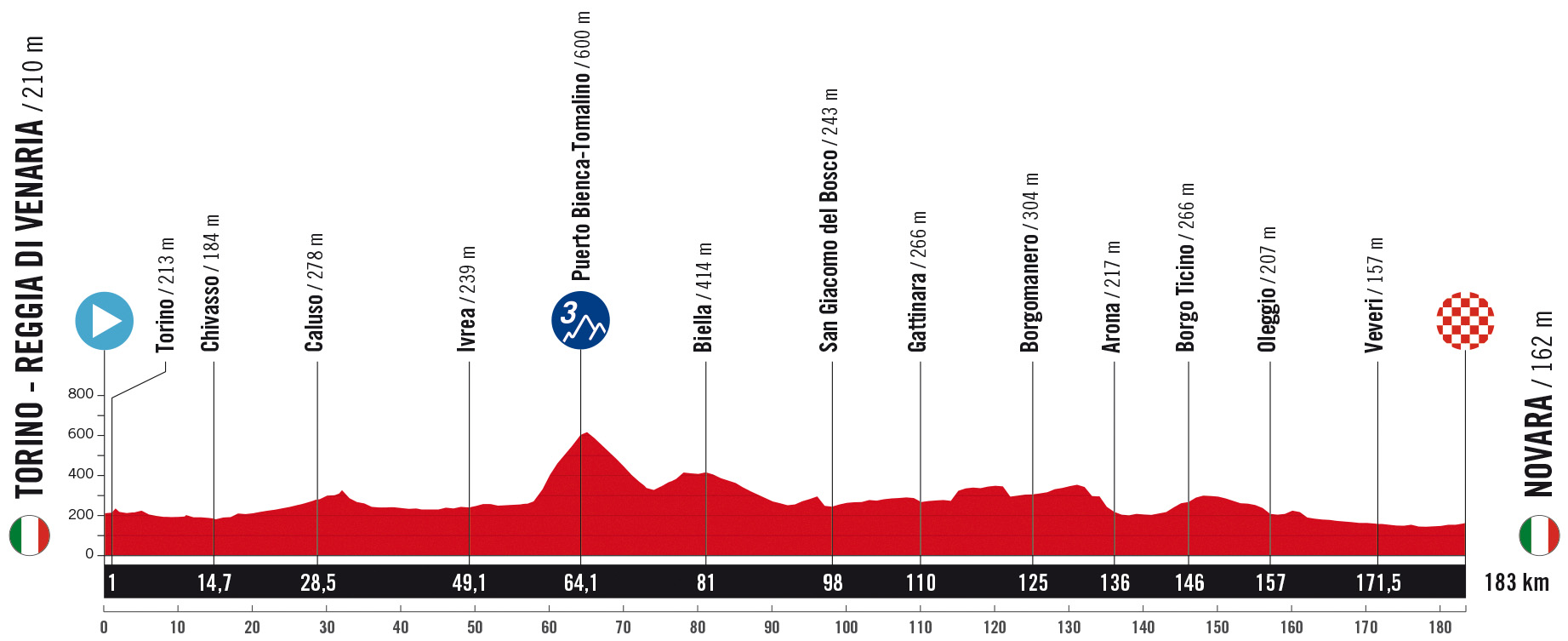
(Image credit: Unipublic)
There will be a sense of whatever the Italian is for ‘déjà vu’ on this opening stage of the Vuelta, as the region of Piemonte will host the Gran Partida — specifically, Turin, which becomes only the second city (following Utrecht) in Grand Tour history to feature in all three Grand Tours having last year hosted both the opening stage finish of last year’s Giro d’Italia and the third stage of the Tour de France.
From Turin the riders will head north and then east to Novara for that rarest of Vuelta stages: a flat opening stage, the first in fact since 2007. In an edition that is typically stingy to the sprinters, the rare opportunity for them to race here not only for a stage win but for the even rarer honour of wearing the red jersey will surely have the fast men extra fired up.
STAGE 2
Sunday 24 August
Alba > Limone Piemonte | 159.6km | Hilly
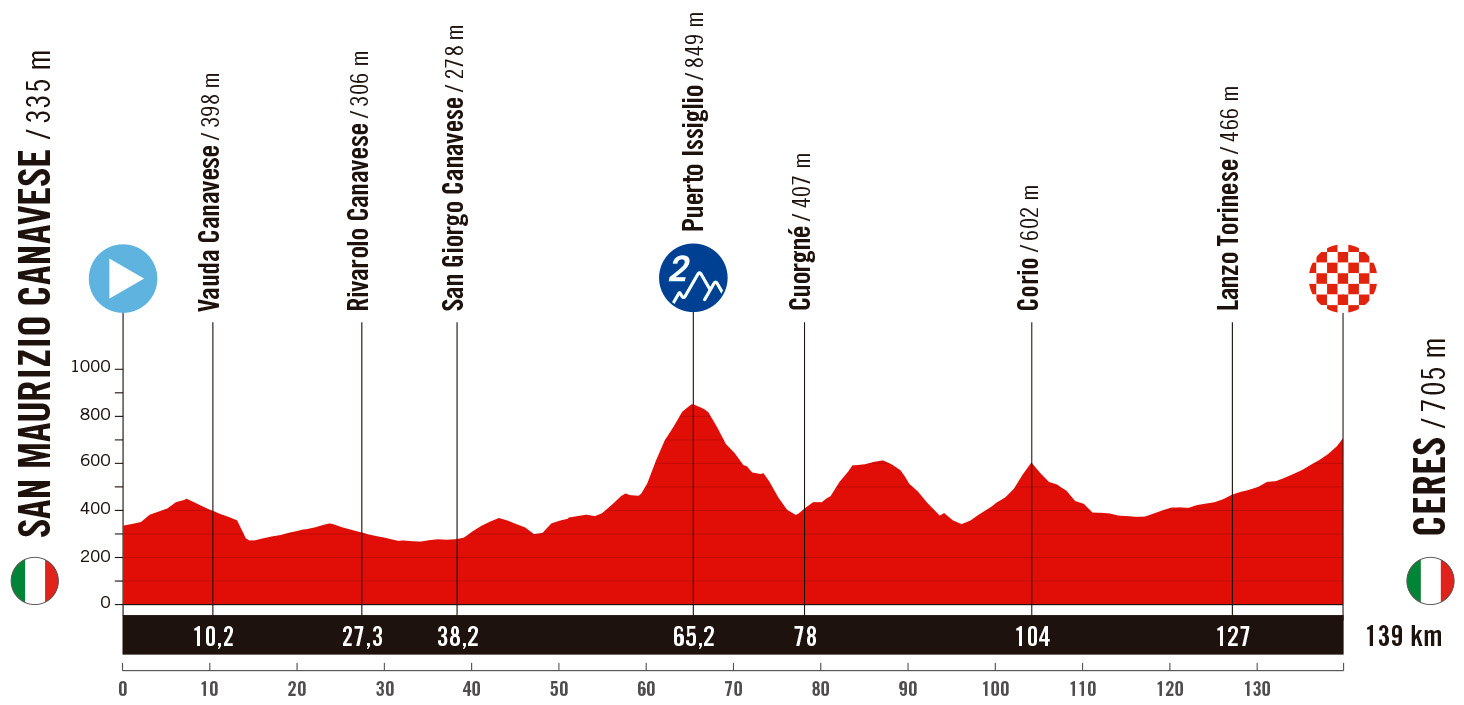
(Image credit: Unipublic)
The home of some of Italy’s most celebrated wines and confectionery, Alba hosts stage two of the Vuelta, though the riders will avoid the tricky terrain of the Langhe hills vineyards where the former is made, instead heading westwards towards the French border.
That’s not to say that climbing is circumvented altogether, however, as an otherwise easy day is abruptly disrupted by the category two climb of Limone Piemonte. Rising at only 5% for 10km, it pales in comparison to the other nine summit finishes to come, but is still hard enough out the GC contenders for their first fight of the race. There won’t be big time gaps, and the top favourites may all finish together in a large group, but in the uphill sprint for the line we’ll get a first sense of who among them is feeling the freshest.
STAGE 3
Monday 25 August
San Maurizio Canavese > Ceres | 134.6km | Medium mountains
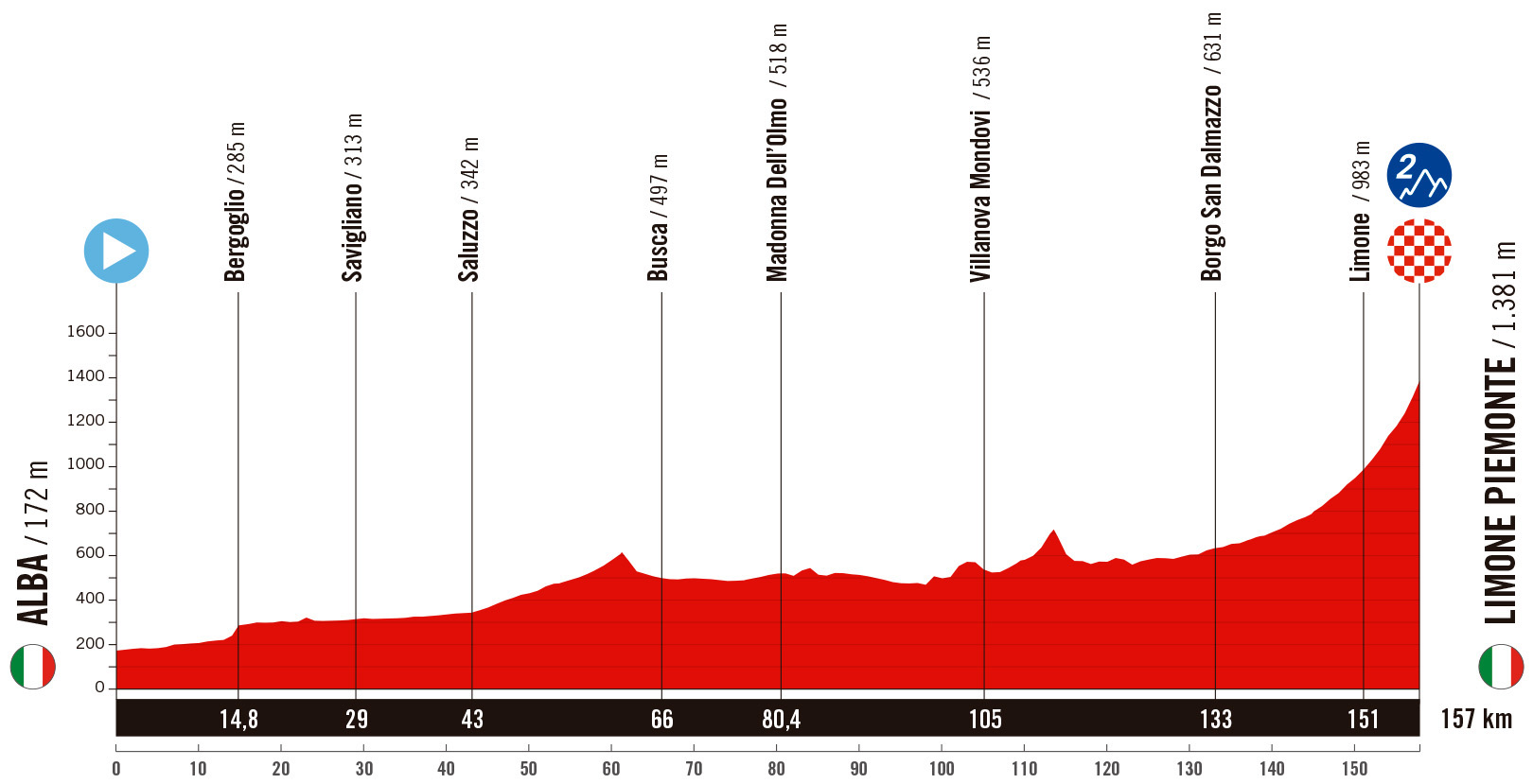
(Image credit: Unipublic)
There might only be two, relatively small categorised climbs to be completed, but make no mistake — this is not a day for sprinters. This third and final stage in Italy takes place against the backdrop of the Graian Alps, and though they’ll stick mostly to the lower roads within the Lanzo Valleys, there’s still enough climbing in the foothills to amount to almost 2000m in elevation.
Most of that climbing comes during the second half of this short stage, starting with the category two Puerto Issaglio and followed by a couple of uncategorised climbs. The draggy, gradual false flat of about 20km to the finish in Ceres, that steepens to 3.6% for the final 2.6km, favours puncheurs with a quick finish and/or sprinters who can climb, but the hilly terrain and winding, technical roads gives the break a good chance to succeed.
STAGE 4
Tuesday 26 August
Susa > Voiron | 206.7km | Medium mountains
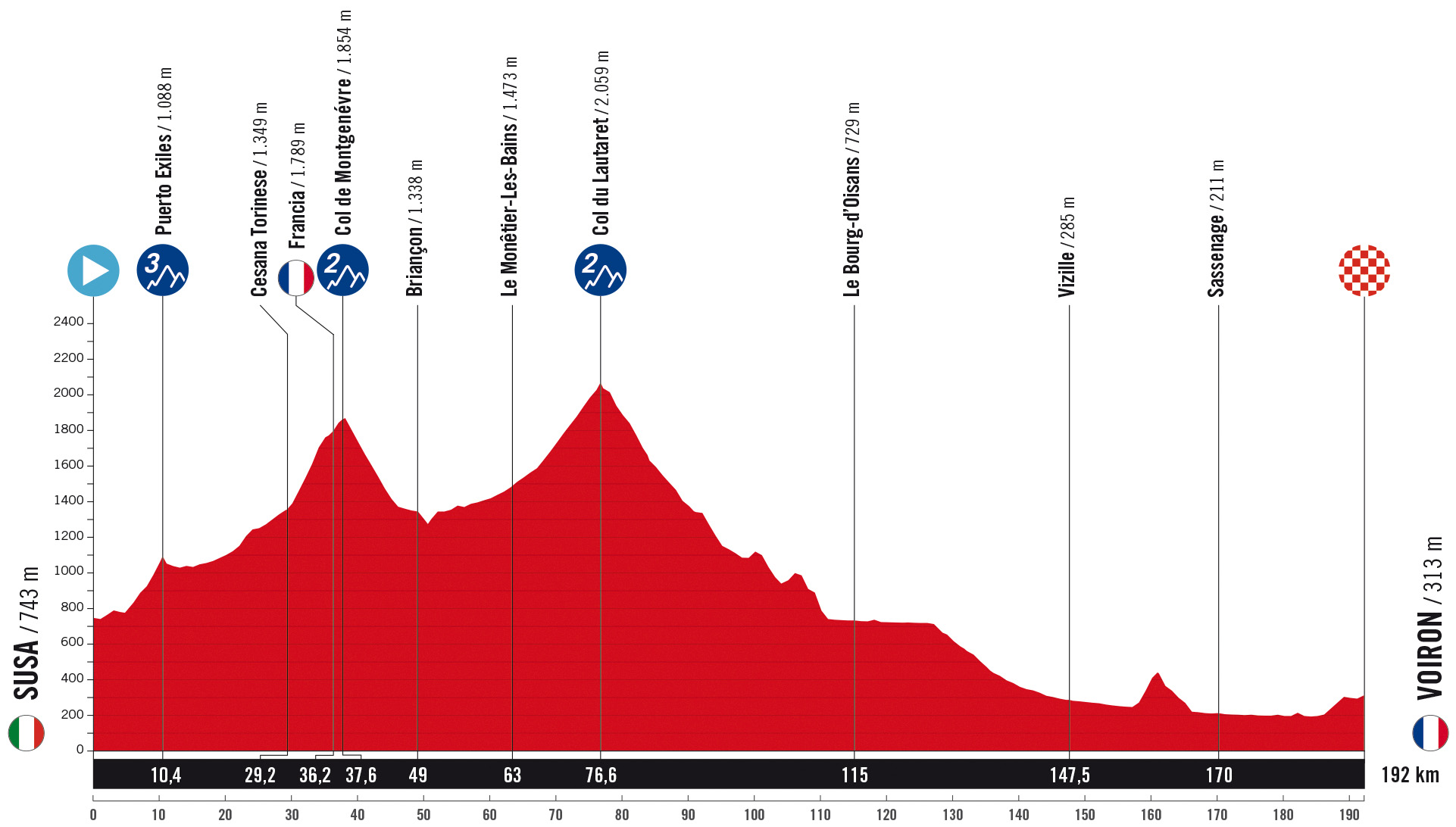
(Image credit: Unipublic)
When is a mountain stage not a mountain stage? The High Alps are visited today as the riders cross the border from Italy and into France, but the tougher summits are avoided with only a couple of category two cols on the menu, before a long descent and then flat run-in to the finish in Voiron.
These climbs come too early in the stage for the overall contenders and their teams to race them hard, but will encourage capable climbers targeting stage wins rather than the GC to get into the break, and upon cresting the Col du Lautaret they have a long, 80km descent to build an advantage. Whether or not they survive the flat 40km run-in to the finish may depend on how many faster men manage to get back into the peloton after the climbs, and how hard their teams chase them down.
STAGE 5
Wednesday 27 August
Figueres > Figueres | 24.1km | Team time trial
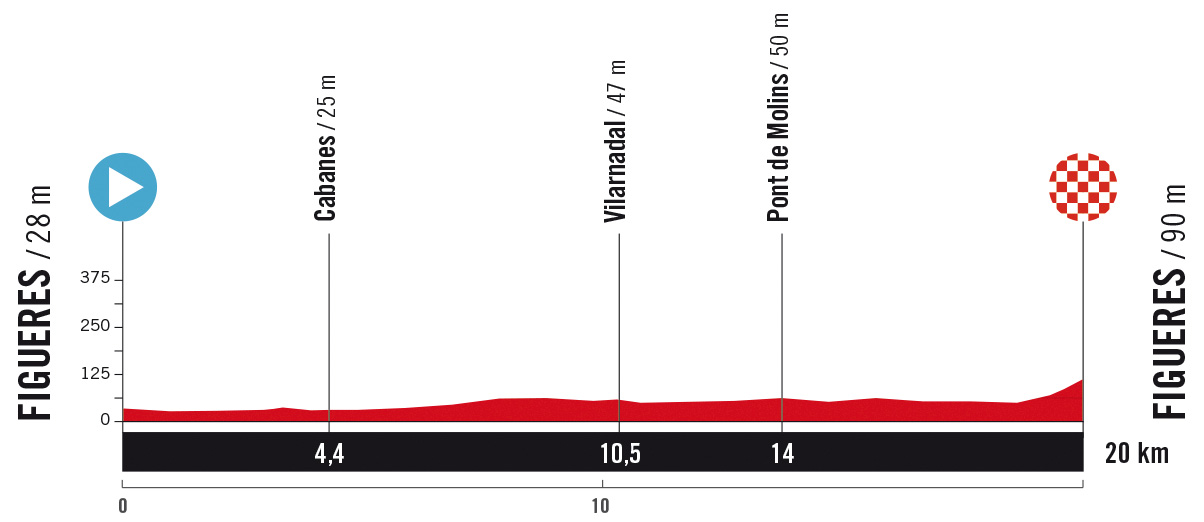
(Image credit: Unipublic)
At long last, the Vuelta reaches Spain — although make sure the locals don’t hear you saying that. Today’s team time trial route is an out-and-back one from Figueras held in Catalonia, a region that is fiercely independent and where there has long been independence movements to separate from Spain.
While much of the region to the north encompasses the Pyrenees, today’s stage takes place on entirely flat roads save for a final kilometre that rises at 4%. But it’s the length that makes this team time trial particularly important — it’s the longest at any Vuelta since a 27.8km stage in 2016, when only five teams finished within the time of the winning team Sky, with Alberto Contador’s Tinkoff conceding 52 seconds. Riders in weaker teams are in danger of being put at a significant deficit ahead of the big mountain stages coming up.
STAGE 6
Thursday 28 August
Olot > Pal. Andorra | 170.3km | Mountains

(Image credit: Unipublic)
You never have to wait long for a mountain top finish at the Vuelta a España, and today’s atop Pal will force the first GC sort out of the race. The riders head into the high mountains of the eastern Pyrenees, against the stunning backdrop of granite rocks that give the range such a rugged appearance, and head to Andorra for the finish — the fourth country visited at this year’s Vuelta, a joint record in the race’s history.
The Collada de Toses tackled one-third into the stage will be the first category one climb of the race, and contribute much of the 3475m elevation gain that make this a full mountain stage. But the GC riders will surely wait for the final 9.6km ascent to Pal to make their moves, where the average gradient of 6.3% should be enough to see gaps open up between them.
STAGE 7
Friday 29 August
Andorra la Vella > Cerler | 188km | Mountains
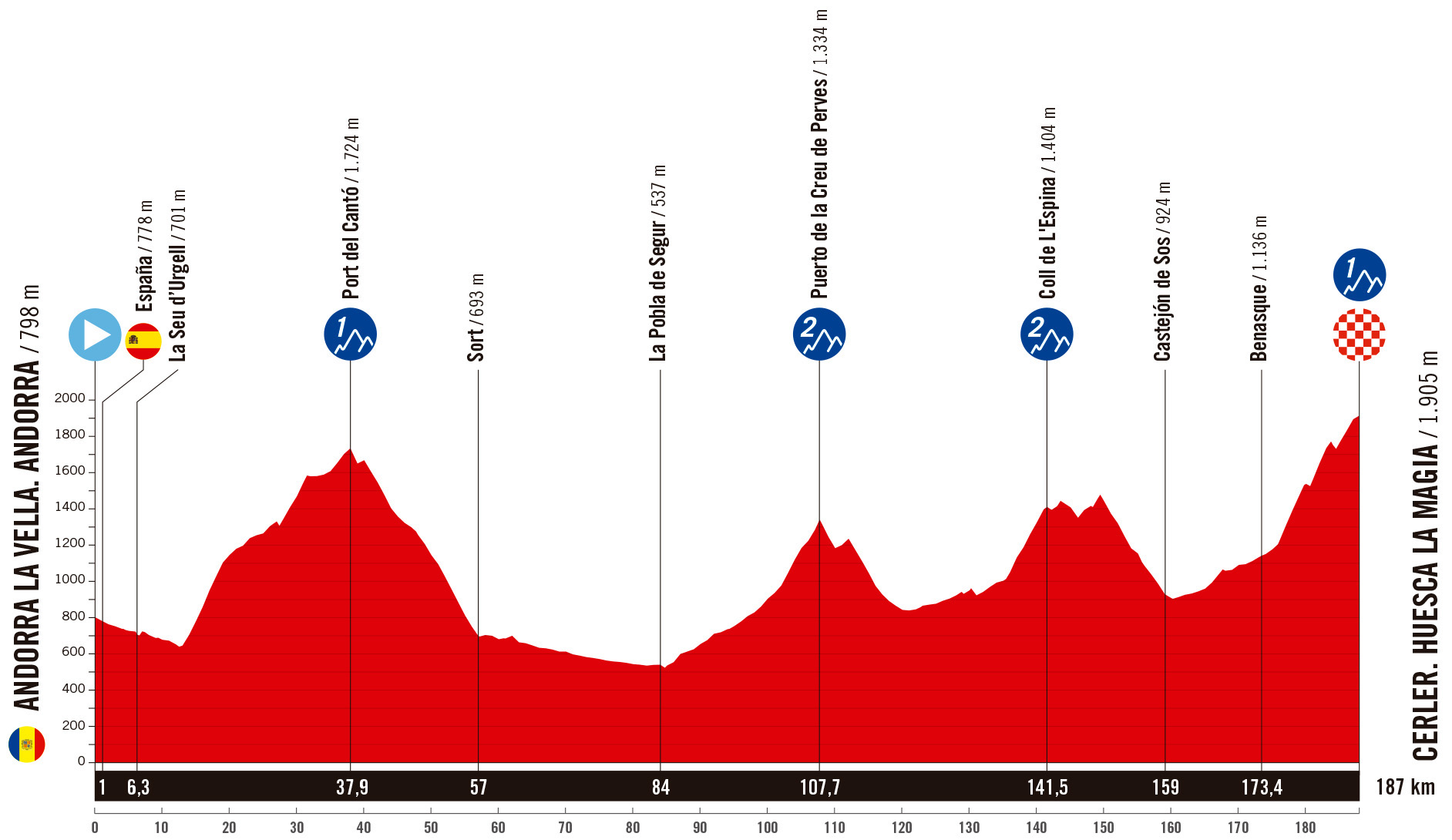
(Image credit: Unipublic)
A quirk of this year’s route is that each road stage from the opener in Piemonte until now has featured more elevation gain than the last, culminating in this monster in the Pyrenees, where the total of 4,211m is the most of any stage so far, and the second most of the race.
The high passes of the category one Port del Cantó and category two Puerto de la Creu de Perves and Coll de l’Espina will wear the riders down ahead of the finishing ascent of Cerler. This 12.1km finale’s average gradient of 5.8% might not seem so scary, but obscures what it’s really like; it’s a stereotypically Pyrenean mountain with uneven gradients, ramping up to double digits in between, that will make it very hard to get into a rhythm on and potentially produce disable gaps between the favourites.
STAGE 8
Saturday 30 August
Monzón Templario > Zaragoza | 163.5km | Flat
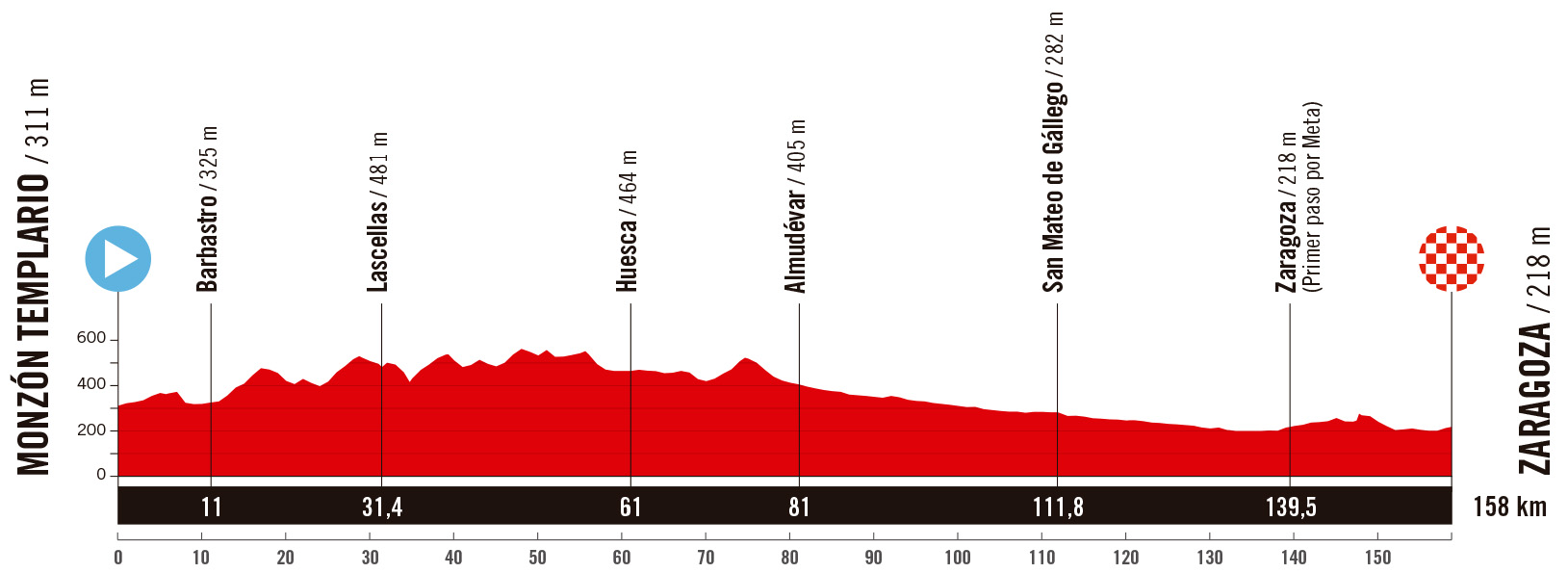
(Image credit: Unipublic)
A detour south out of the Pyrenees and into the plains of Aragon offers the sprinters a rare flat stage to flaunt their stuff, and it’s one they can ill-afford to let go — after this they won’t have another chance of a stage win until deep into the final week.
Zaragoza is a common destination for the Vuelta and often sees a bunch sprint, as was the case two years ago when Juan Sebastián Molano got the better of Kaden Groves, but the westwards approach from the start in Monzón subject the riders to exposed roads, so echelons could complicate matters should the wind blow strong enough and in the right direction. And more complications await upon entering Zaragoza, which, as a built-up metropolis, features many winding urban roads and tight corners to try to stay upright navigating.
STAGE 9
Sunday 31 August
Alfaro > Valdezcaray | 195.5km | Mountains
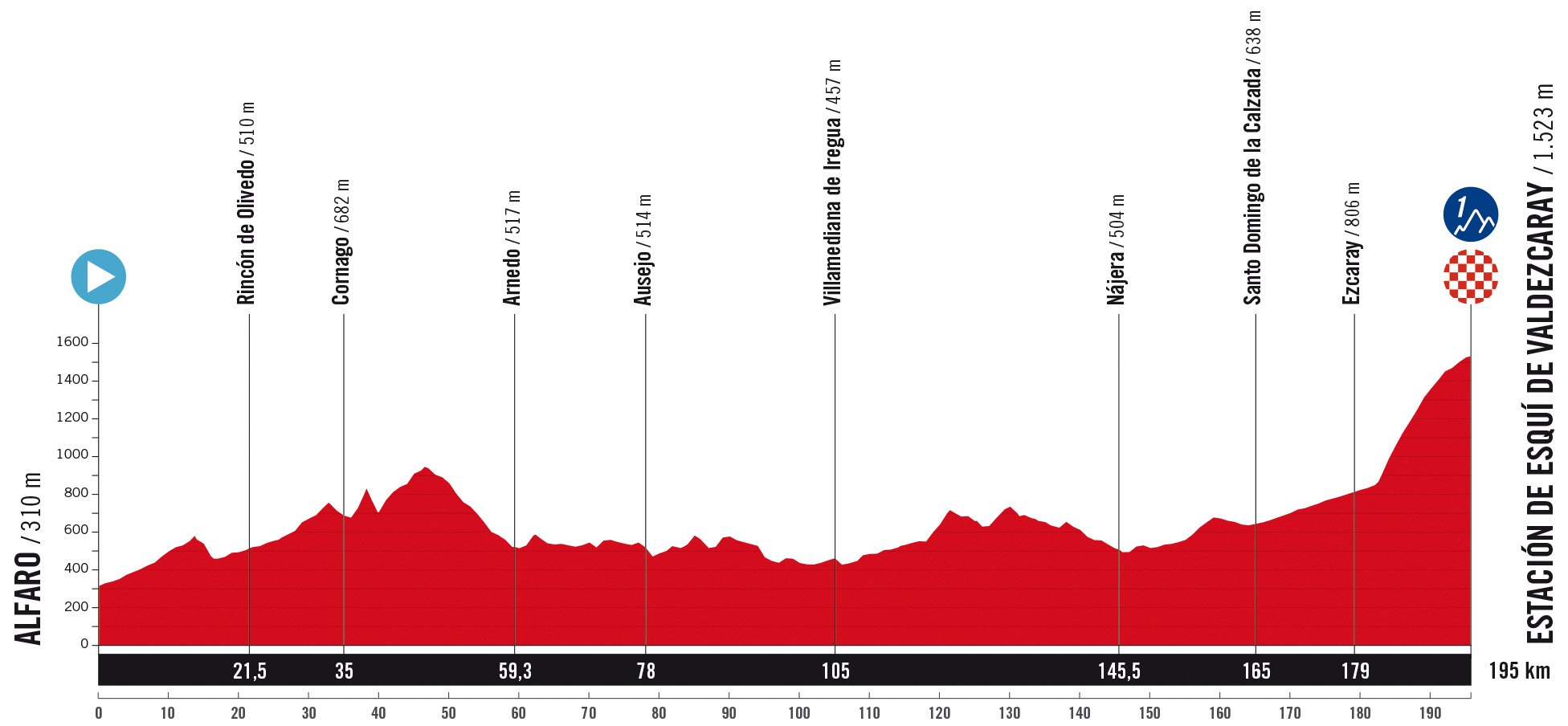
(Image credit: Unipublic)
The first week comes to a close with the historic summit finish at Valdezcaray, a climb that has seen the likes of Sean Kelly and Pedro Delgado triumph on during their overall Vuelta victories in the 1980s. Yet despite that illustrious list of past winners, the climb isn’t hard enough to cause many, if any, time gaps, between the top GC contenders, its average gradient of 5% too modest even over the course of 13.2km.
Of more concern might be the run-in to the climb. The last time a stage finished atop Valdezcaray in 2012, Team Sky split the peloton in the wind, an incensed Alejandro Valverde among those to lose time after he was caught up in a crash. This year the race approaches Valdezcaray from the east rather than the north, but the roads are similarly flat and exposed.
STAGE 10
Tuesday 2 September
Arguedas > El Ferial Larra Belagua | 175.3km | Mountains
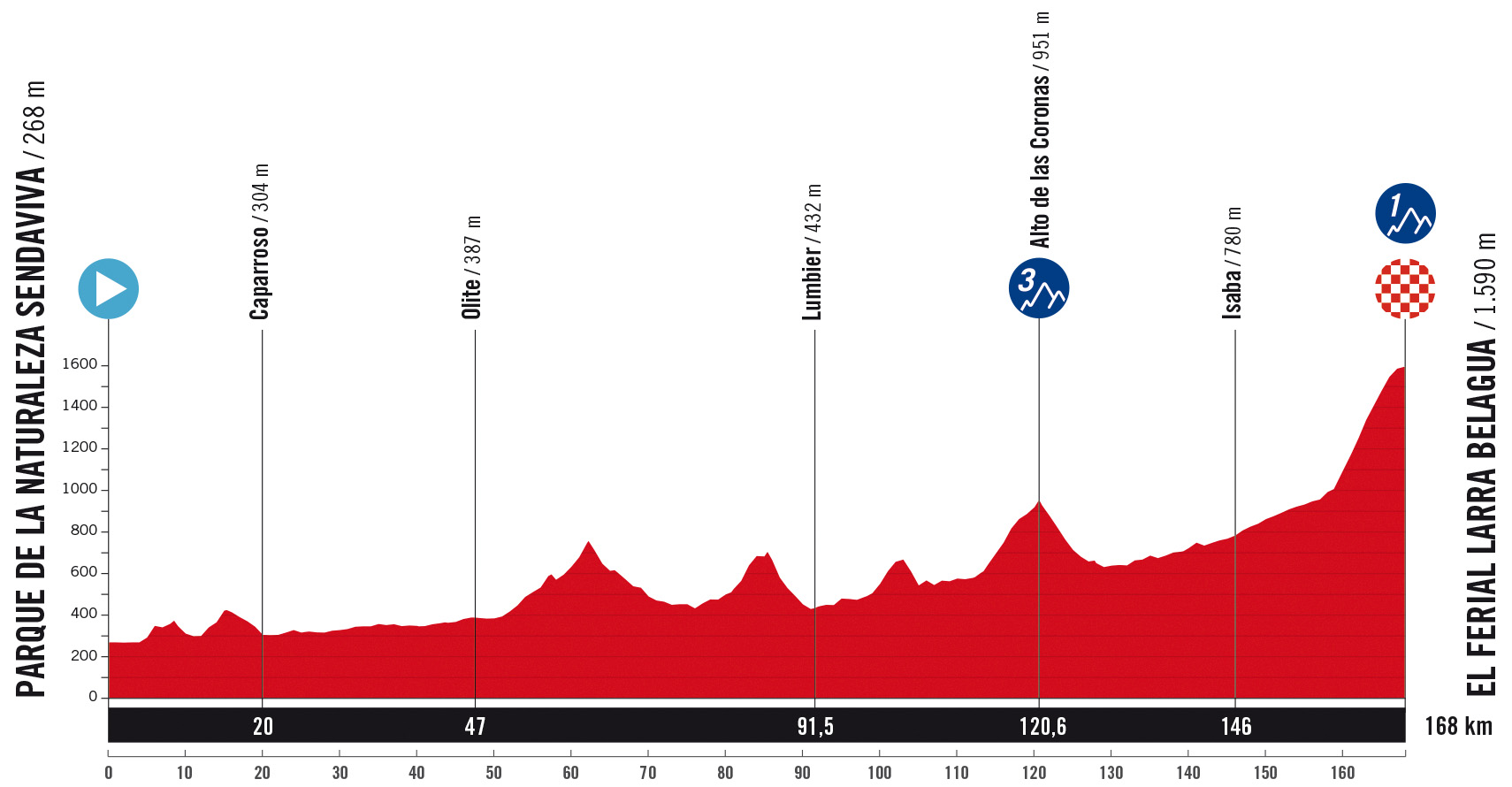
(Image credit: Unipublic)
Two years after a tearful Remco Evenepoel claimed victory at its summit, bouncing back after being dumped out of overall contention just 24 hours earlier, the Vuelta returns to Larra Belagua for another summit finish in the Pyrenees.
This stage looks more likely to be one to break a rider’s GC ambitions than redeem them. The return to racing after a rest day often catches riders out, and the risk of the final 9.4km climb coming as a shock to their legs is exacerbated by the fact it’s preceded by mostly flat and rolling roads. That said, though there are a few 9% ramps on its lower slopes, the climb’s average of 6.3% isn’t too troublesome, and the way it eases off for the final few kilometres to the top will likely limit the potential for differences between the GC riders.
STAGE 11
Wednesday 3 September
Bilbao > Bilbao | 157.4km | Hilly
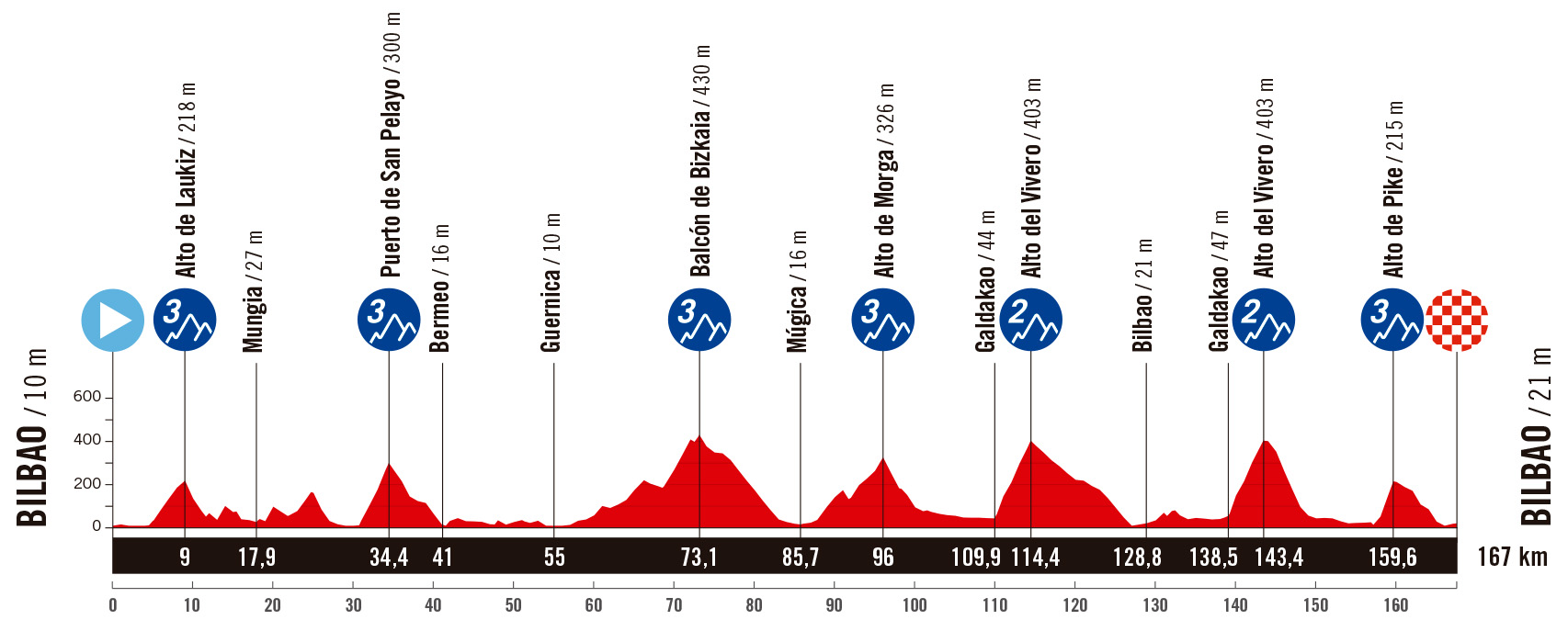
(Image credit: Unipublic)
A transfer westwards brings the rider to Bilbao for a stage in the Basque Country, where the riders will be challenged by the region’s characteristically punchy terrain, sometimes adverse weather, and narrow roads made even narrower by the swarms of orange-clad cycling-mad fans.
This was the location of the raucous Grand Départ of the 2023 Tour de France, and the route today is strikingly similar, featuring many of the same climbs. That includes the double ascent of Alto del Vivero (4.2km at 8.3%) and final climb of Alto de Pike (2.3km at 8.9%), both of which could see explosive attacks from the GC riders. But it’s the accumulated fatigue built up over the day’s seven categorised climbs (more than any other stage of this year’s race) that will pose a different test to the GC contenders to anything raced so far.
STAGE 12
Thursday 4 September
Laredo > Los Corrales de Buelna | 144.9km | Medium mountains
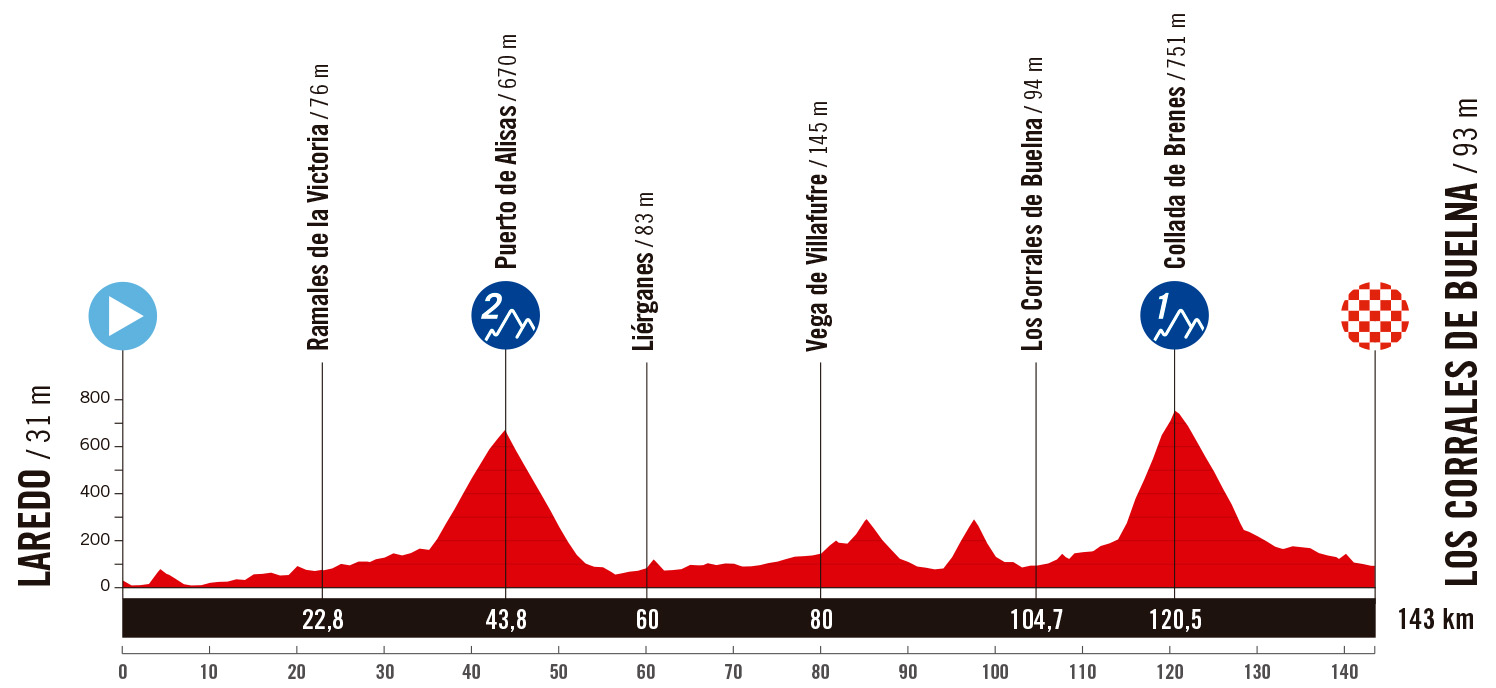
(Image credit: Unipublic)
Were this stage to finish upon reaching the finish line for the first time, it would likely have been one for the sprinters, with only the single category two Puerto de Alisas early on disrupting the otherwise flat terrain. But the Vuelta organisers can’t resist a climb, and instead send the riders on a loop southwards to take on the category one Corrales de Buelna.
Averaging 7.9% for 7km, it’s steep enough to potentially tempt GC riders into attacks, especially those who feel confident descending, for whom the fast downhill back to the finish in Los Corrales de Buelna presents an opportunity to put pressure on those less technically accomplished. In terms of the stage win, this does look like a promising day for the break, which could feature several climbers and puncheurs should it form on the Puerto de Alisas 41km into the stage.
STAGE 13
Friday 5 September
Cabezón de la Sal > L’Angliru | 202.7km | Mountains

(Image credit: Unipublic)
Alto d l’Angliru — the name alone is enough to strike fear into anyone who’s tried to ride up it, and goosebumps in spectators who have watched riders race here at past Vueltas. Since first hosting a stage finish in 1999 it’s quickly become legendary for its ultra-steep gradients, especially the 6km Cueña les Cabres goat track that rises for 13% with many ramps over 20%, and is widely considered the hardest mountain of the Vuelta, and possibly among all the Grand Tours.
If that wasn’t enough, the organisers have included almost 200km of racing even before they start it, some of which will be spent climbing two other steep category one climbs in Asturias: Alto de Mozqueta (6.3km at 8.4%) and the Alto de Cordal (5.5km at 8.8%). They’ll be exhausted by the Angliru, where there’s potential for race-defining carnage.
STAGE 14
Saturday 6 September
Avilés > La Farrapona. Lagos de Somiedo | 135.9km | Mountains

(Image credit: Unipublic)
We’re in the remote part of Western Asturias for another day in the high mountains taking in the region’s beautiful green vistas and rugged, limestone summits. At 136km, it’s almost half the length of yesterday’s arduous slog, but shorter doesn’t necessarily equate to easier — the total elevation of 3,805m is in fact only fractionally less than yesterday’s, and the intensity of the climbing might make it an even more taxing day in the saddle.
The GC action could kick off on the day’s penultimate mountain, Puerto de San Lorenzo, which rises at a horribly steep 8.5% for 10km. But the hardest climb will again be the finishing one of Alto de la Farrapona, which ascends unevenly for about 10km before ramping up to over 10% for the final 6km, making it the hardest and likely most selective mountain until late in the third week.
STAGE 15
Sunday 7 September
Vegadeo > Monforte de Lemos | 167.8km | Medium mountains

(Image credit: Unipublic)
Though there is still more climbing to be done before leaving Asturias in the opening third of this stage, the terrain settles into more undulating roads upon entering eastern Galicia. The Puerto a Garganta (16.5km at 5.1%) that begins the stage and subsequent Alto de Barbeitos (11.9km at 3.9%) will therefore likely be springboards not for more attacks from the GC contenders, but rather those wanting to get into the break for a shot at the stage win.
Many in the peloton will be hoping that, once the break is formed, this will become a premature rest day before tomorrow’s official one, and the terrain certainly feels like prime breakaway territory. But four years ago, on an almost identical route, the sprinters’ teams chased all day before coming just 18 short of making the catch, so its success isn’t a foregone conclusion.
STAGE 16
Tuesday 9 September
Poio > Mos | 167.9km | Medium mountains
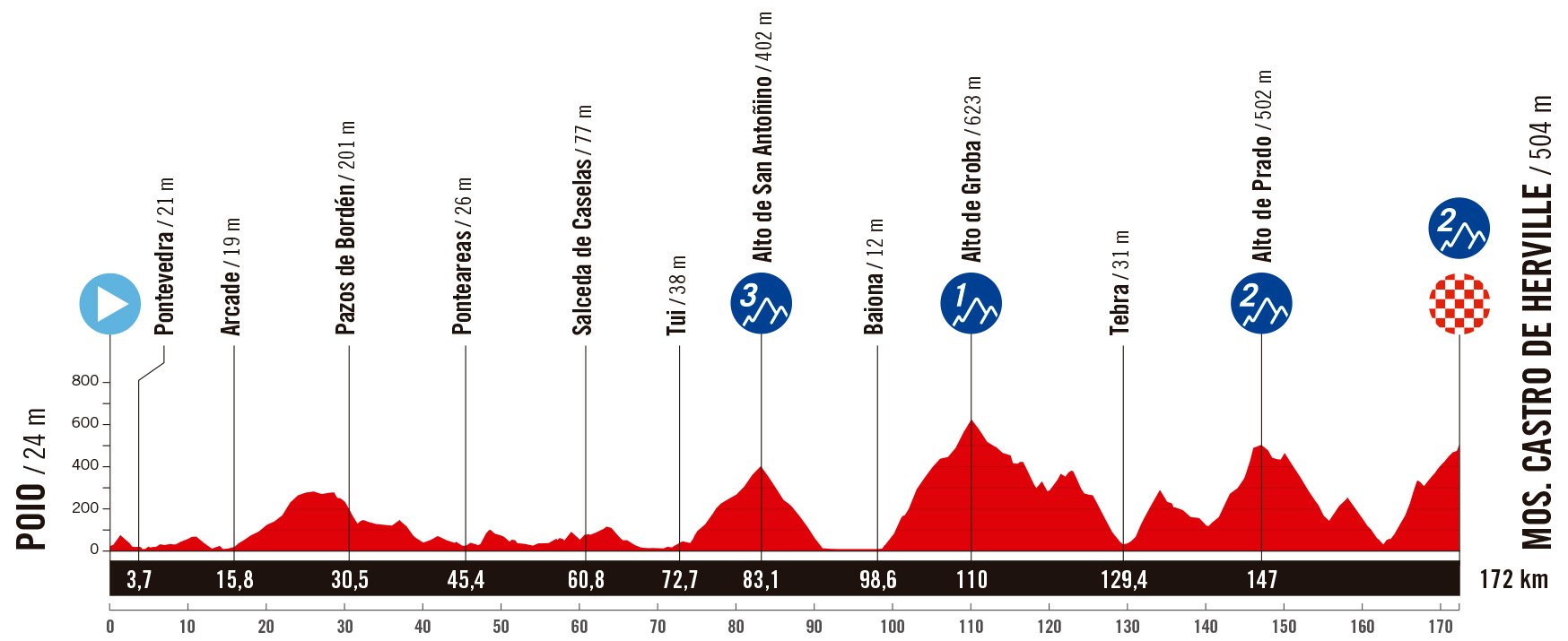
(Image credit: Unipublic)
The summits here in the lusciously green Galicia, host to this Vuelta’s westernmost stage, aren’t especially high, reflected by the fact that the highest point of today’s stage is a mere 623m. But there are lots of them dotting the landscape, amounting to a total elevation gain of 3,472m that’s nearly as much as the mountain days in Asturias.
This could therefore be terrain for some surprise GC attacks, despite the lack of single standout climb. Rather than wait for the final climb of Alto Castro de Herville, which eases off to an average of less than 3.5% for the final 5.5km after a much steeper first 3km, those boldly wanting to gain significant time might seek to make moves on the steeper Alto de Prado and longer, category one Alto de Groba that precede it.
STAGE 17
Wednesday 10 September
O Barco de Valdeorras > Alto de Morredero | 143.2km | Mountains
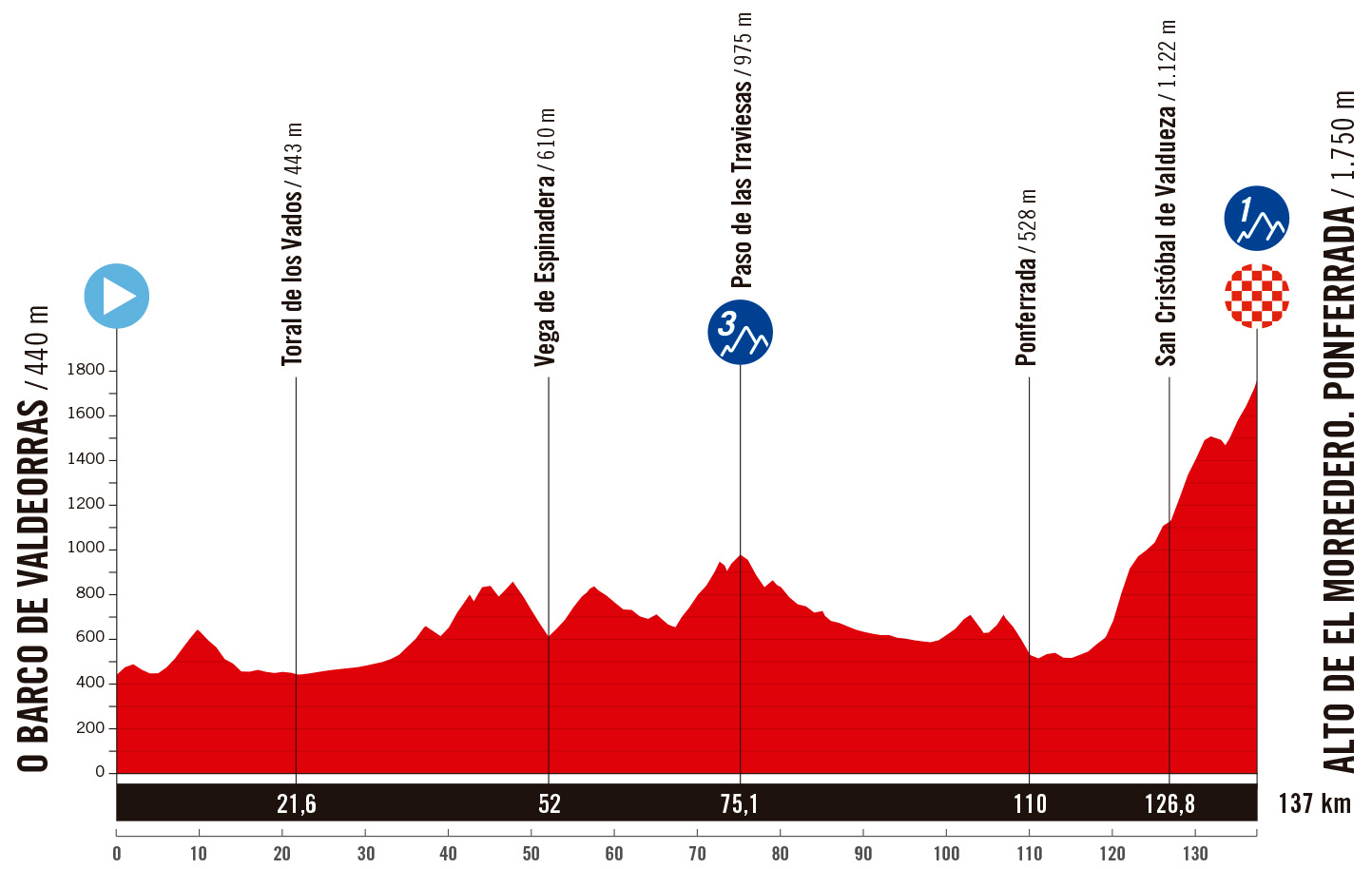
(Image credit: Unipublic)
You may remember Ponferrada as home of the 2014 World Championships, when young outsider Michał Kwiatkowski sneakily slipped clear of the group of favourites to deny home favourite Alejandro Valverde, and the same small couple of small hills that formed the cornerstone of that circuit are tackled in the final 40km today. The difference is that this time, upon exiting Ponferrada, they will climb up the Alto de Morredero, a mountain which Valverde has happier memories from having won atop it the last time the Vuelta visited in 2006.
The Morredero is a seriously difficult climb, with some of the steepest gradients the riders have faced all race. They will already have been climbing for sometime by the official start of the climb, from where the 8.8km to the top average a devastating 9.7%.
STAGE 18
Thursday 11 September
Valladolid > Valladolid | 27.2km | Individual time trial

(Image credit: Unipublic)
Time for something different. After weeks of being tested by a variety of hills and mountains, today’s stage in Valladolid will pit the GC contenders against the clock in the only individual time trial of the race. And it’s one where the specialists can really make a difference, consisting of entirely flat roads, and, after a more technical start featuring 10 corners in the first 10km, ending with a long, 8km straight section where they can maximise their advantage.
The 27.2km course is a replica of the time trial from the 2023 edition, won by Filippo Ganna, and the gains of 55 seconds and 1:01 that Remco Evenepoel achieved over other recognised time trialists João Almeida and Jonas Vingegaard, and 1:30 and 2:05 over weaker time trialists Enric Mas and Mikel Landa, indicate that the gaps today could be big.
STAGE 19
Friday 12 September
Rueda > Guijuelo | 161.9km | Flat

(Image credit: Unipublic)
At long last, a day for the sprinters. It won’t be a straightforward finish in Guijuelo, where the long, 3.5km finishing straight drags up at a gentle gradient to the line, but there isn’t an official climb to negotiate all day and a bunch sprint is therefore the most likely outcome.
That said, there are some complicating factors that could complicate the peloton’s chase of the break. It’s always more difficult to control the race this deep into a Grand Tour, what with fatigue and depleted teams, and the terrain today in Castile and León might be better described as undulating rather than flat. Heat could also take its toll, in a region that, as evidenced by the parched grass that characterise the landscape, contrasts starkly with the greener northern regions the Vuelta has thus far spent time in.
STAGE 20
Saturday 13 September
Robledo de Chavela > Bola del Mundo | 165.6km | Mountains
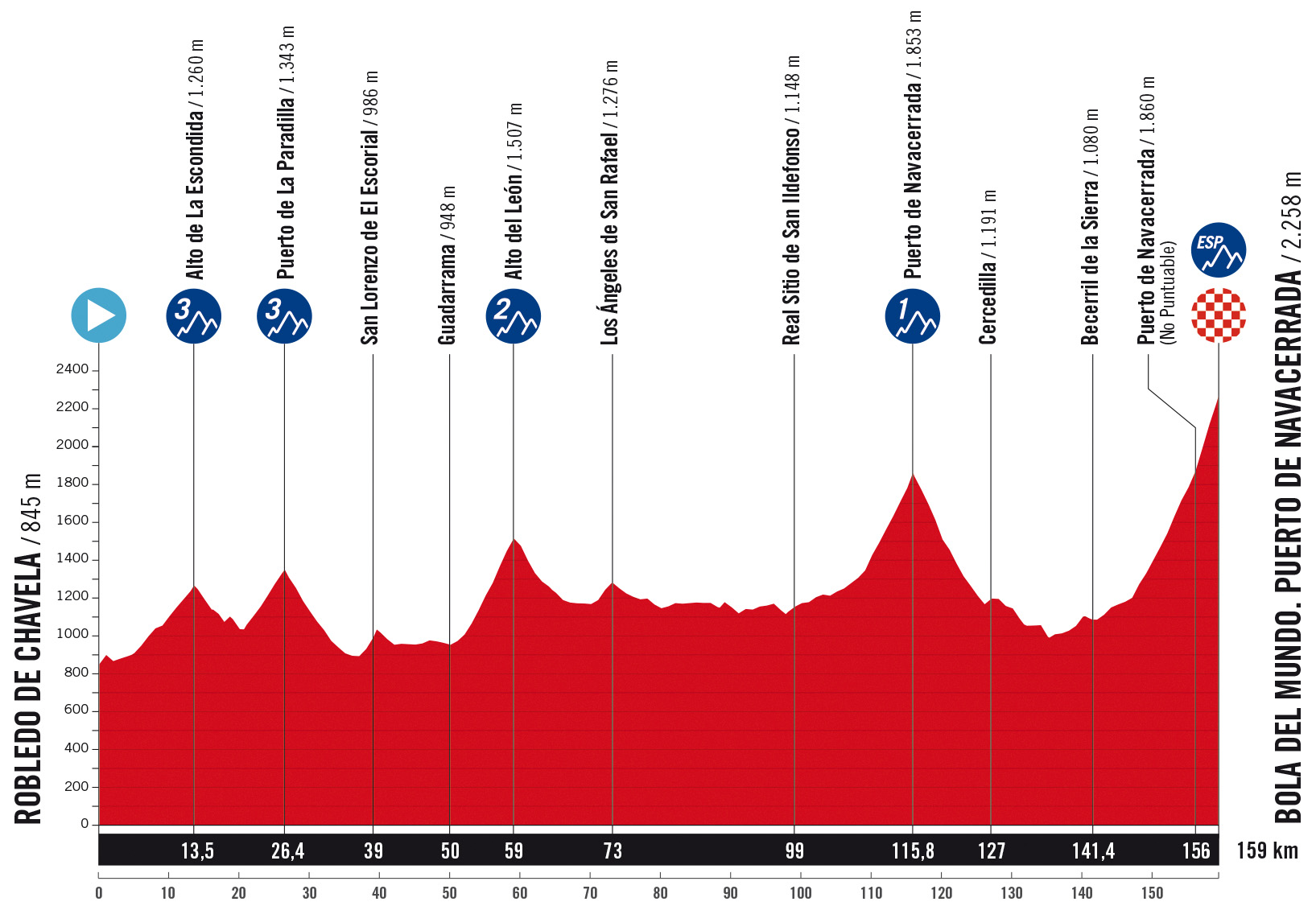
(Image credit: Unipublic)
One day before gliding into Madrid for the race finale, there’s one last chance for a GC shake up in the mountains of the Sierra de Guadarrama that surround the capital. And with a total of five classified climbs and race-high elevation gain of 4,226m, the parcours is hard enough to upend the race even at this late stage.
Of those mountains, the Puerto de Navacerrada is to be the stage’s definitive test. It will be tackled twice in the finale, via its northern side that rises for 6.9km at 7.6%, and then its longer (9.1km) and only slightly shallower (7.3%) southern side, and this time with a sting in the tail — the Bola del Mundo, a narrow and horrendously steep 3km addition on rough concrete track that averages 12.2% with potentially race-defining ramps of over 20%.
STAGE 21
Sunday 14 September
Valdeolmos-Alalpardo > Madrid | 111.6km | Flat
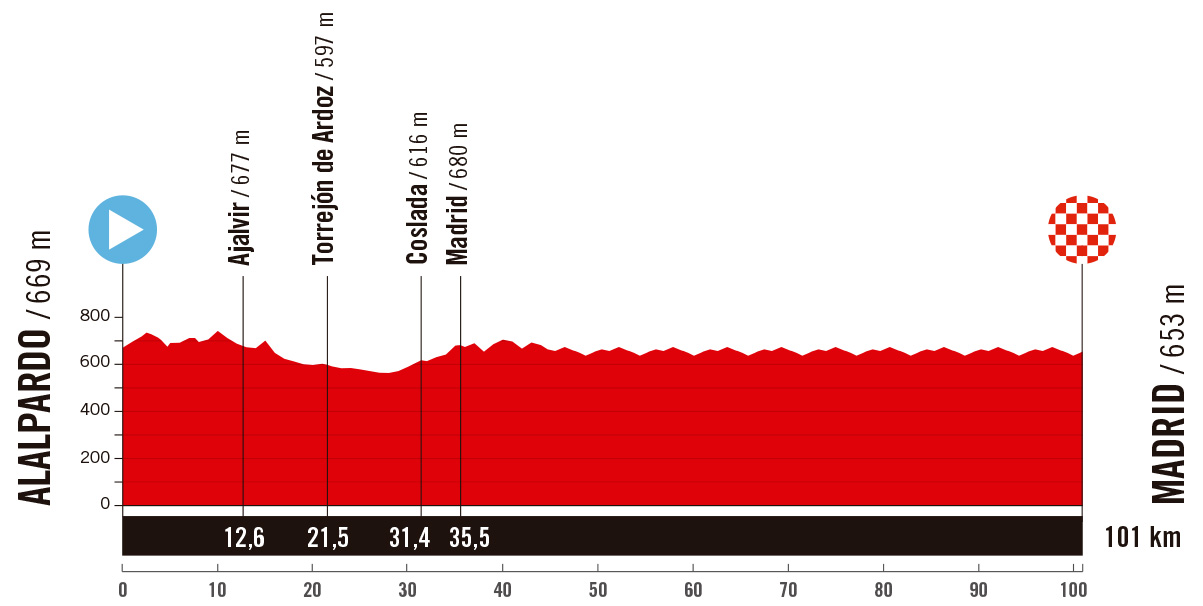
(Image credit: Unipublic)
Received wisdom has it that the final circuit stage of a Grand Tour is a ceremonial procession that ends in a guaranteed bunch sprint, but the rules were ripped up two years ago in Madrid at the Vuelta. A restless Remco Evenepoel attacked about 38km from the finish and took with him an all-star 6-man group also containing Filippo Ganna and Kaden Groves, and they just about held off the chasing peloton all the way to the finish, Groves outsprinting them to take the win.
A repeat of their success is possible today, given that the riders take on exactly the same circuit in Madrid. It’s not the flat terrain that’ll encourage attackers, but rather the number of corners to navigate — aside from one 2km stretch, there isn’t more than 1200m without a sharp turn, making it hard for the peloton to retain top speed in their pursuit.
Explore More
